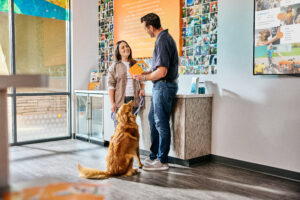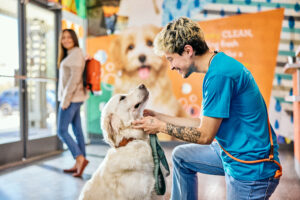Pet-Proofing Your House

Dogs bring so much joy to our households and family life. However, they can be quite curious and mischievous by nature and often see everything in your home as a potential toy that can be chewed.
As a pet parent, it is important to make sure your home is thoroughly pet-proofed to not only protect your possessions and valuables, but also keep your pup healthy and safe. Follow these five easy tips to ensure that your home is suitable for your new furry friend.
Check for hazards
It is important to do a complete sweep of any hazardous objects in your home. One effective way to do this is to start by getting down on your hands and knees so you can see each room from your pup’s eye level. This can alert you to any unseen hazards such as, coins dropped, medication, candy wrappers, game pieces and anything else you wouldn’t want your dog ingesting.
Puppies and even older dogs love to chew just about anything they can get their paws on, so keep electrical wires, dangling blind cords, and all sharp objects out of reach. It is also a good idea to cover your outlets with outlet plugs.
Get a trash can your pup can’t open
Trash cans are a haven of interesting and exciting smells to a curious dog’s nose. It is vital to keep them covered and closed. Without a properly secured trash can, you may encounter your garbage sprawled on the floor, a sick pup who vomits or has left diarrhea in unexpected places. This could also cause an intestinal blockage that can be very costly to remove at your vet.
For larger dogs, the most effective solution is a pull-out trash can. Although it can be quite costly to implement, it is the best option for keeping food-motivated dogs away from garbage. For smaller dogs, a sturdy metal trash can with a step-on lid should be enough.
Check for poisonous plants
While plants create a relaxing and comforting home environment, they can also cause serious issues to your pup such as mild irritation and digestive upset, if ingested. Some of the most common plants that should be removed from a pup-friendly home include:
- Aloe vera
- Boston ivy
- Caladium (elephant ear)
- Dieffenbachia (dumb cane)
- Peace and Easter lily
- India rubber plant
- Bird of Paradise
- Philodendron
- Chrysanthemum
Lock up your poisons
Most homes are bound to have some toxic substances and chemicals that need to be locked away from furry family members. This includes household cleaners, detergents, anti-freeze, glue, aerosol sprays, yard and automotive chemicals and any toxic substances. It is best to keep such products on a top shelf, where they can’t be reached.
If you think your pet may have ingested a potentially poisonous substance, please contact animal poison control.
Keep closets and drawers shut
Assuming you’d like to keep your wardrobe or dresser intact and your furry friend safe, it is a good idea to keep drawers and closets closed when they are not being used. Closets and drawers can have many objects your pup may find interesting like shoes or dangling belts/ties. This can be particularly dangerous if your pup gets entangled in them or swallows them.
When it comes to pet-proofing your home, it is important to view everything in your home as a potential chew toy. If there’s something you would not want your pup to get their paws on, it’s best you lock it up and away from their reach. Although the task may seem daunting, pet-proofing your home is definitely worth the time and expense to keep your furry family member healthy and safe!











